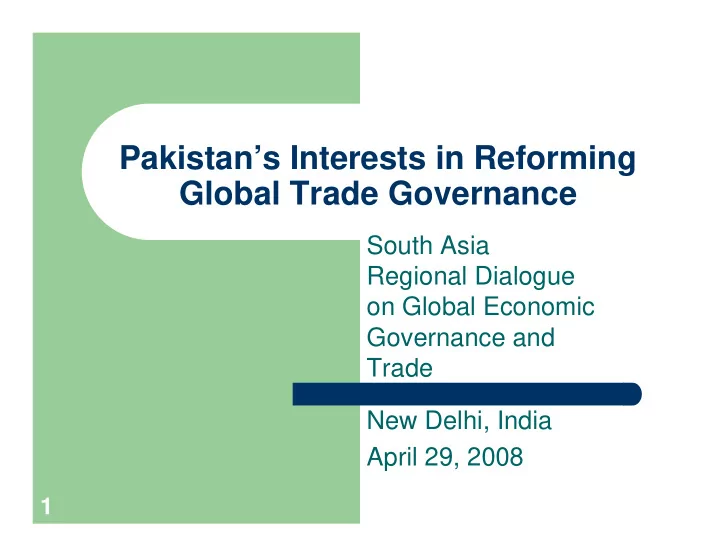

Pakistan’s Interests in Reforming Global Trade Governance South Asia Regional Dialogue on Global Economic Governance and Trade New Delhi, India April 29, 2008 1
Structure of the Presentation This presentation consists of: � Part I(a): Defining ‘interests’ and ‘reform’ � Part I(b): Pakistani Economy � Part II: Pakistan’s position & expectation from the on-going negotiations in Agriculture � Part III: NAMA Negotiation 2
PART I: Introduction 3
Defining ‘Interests’ and ‘Reform’ � Reform: – Identifying Shortcomings – the Doha mandate – Nature & process of reform – trading off of interests, negotiating power and the need to align interests with others � Interests – General Systemic Interests – Specific Economic Interests 4
Pakistan: Basic Info (2006-7) � Population: 162 million � GDP growth rate: 8.5% � Per Capita Income: $788 � Exports: US$18.87billion � Imports: US$22.7 billion � Agriculture dominates � Textile-centric industry � Growing Services 5
Pakistan: Basic Info (Contd. 1) � Three Policy Pillars: De-regulation, Liberalization & Privatization � Integration through FTAs � Trade profile is different from other South Asian countries: most liberal in SA (world bank), Tilted market access etc 6
� PART II: Pakistan’s Interests in Agriculture Negotiations 7
Agriculture in Pakistan � Dominant sector in the economy – GDP (23%); Employment (42%); growth rate 7.5% � NFIDC: 72 out of 120 districts net food deficit � 2006-07 Exports: US$1.8b; Imports: US$2.2b � Key exports: Cotton, Rice & some fruits � Key imports: edible oils, Wheat (irregular) and high value dairy products 8
Agriculture in Pakistan (contd. 1) � Winners: Cotton, Dairy, livestock & fisheries. Potential in Value added agricultural products � Losers: Production of Wheat, pulses, sugar to lag behind domestic demand by 2015 � Substantial imports would be necessary (7 million MT of wheat every year by 2020) � Serious food security concerns 9
Pakistani Agriculture in WTO context: Policy Environment � Low level of assistance – Focus on wheat and sugarcane (80% in 1995-2000) – Mainly green support � Liberal import regime – Low applied tariffs (0-30%) – high bound tariffs (100%) � High level of government intervention – Role is declining 10
Pakistani Agriculture in WTO Context (Market Access) � 85% of agriculture tariff lines are bound, mostly at 100% � Tea, Maize, Wheat & Sugar bound at 150% � Low Applied levels, on average at 25% � Imports by private parties allowed 11
Pakistani Agriculture in WTO context (Domestic Support) � 11 products received support in 1995 � The AMS during the base period (1986-88) was US$640 million. � Present AMS is negative; -7.6% of the total agriculture production. � Till 2001-02 there were some non-product specific AMS in form of electricity subsidy 12
Pakistani Agriculture in WTO context (Export Competition) � Prior to the WTO Pakistan provided direct export subsidy to Cotton and Rice; now abolished � Limited freight subsidy for fresh fruit & vegetables. Total value of this subsidy in 2001- 02 was US$2.8 million 13
Measuring a “Successful” Round for Pakistan Agriculture � Large increase in market access (tariff cuts) � Tariff caps of 100% (developed) � Limited # of ‘exemptions’ (Sensitive, Special) � Broad definition, tariff cuts for tropical products � Effective cut to tariff escalation � Large reductions in domestic support (cotton) � Export subsidy phased out quickly 14
Objectives of the WTO Agriculture Negotiations for Pakistan � Lead & support the Cairns, G33 and G-20 coalitions � Secure reduction commitments in disruptive support and protection of other countries � Secure improved access to international markets for the competitive export sectors � Limit adjustments for most vulnerable sectors � Respect the food security requirements of consumers 15
Reduction in Support and Protection: Three Pillars � Market Access (Offensive Interest) – Largest gains – Least developed pillar � Domestic Support – Limited commercial impact, but politically charged � Export Competition – Limited impact, need consistency with other sectors – Pakistan has both ‘defensive’ and ‘offensive’ interests 16
Part III: Pakistan’s Interests in NAMA Negotiations 17
Industrial Sector in Pakistan � Limited industrial base � Textiles dominate the sector – GDP (48%); Exports (68%); growth rate 3.5% � 2006-07 Exports: US$16.7b; Imports: US$20b � Key exports: Yarn, Knitwear � Key imports: machinery, cars 18
Industrial Sector in the WTO Context � 98.7% of tariff lines are bound � Bound in the range of 5% to 25% � Applied tariff in the range of 0% to 25% 19
Issues in NAMA for Pakistan � Simple Swiss formula with two coefficients 6 and 30 � Preference erosion � Joining sectoral negotiations? – e.g. Turkish proposal on textiles � Flexibilities, which sectors to protect? 20
Pakistan’s Defensive Interests � Revenue implication from tariff reduction not substantial – decreasing customs revenue contribution (autonomous liberalisation) – maximum tariff at 25% already with few exceptions – Reductions to take place from bound rates not applied � Pakistan has a lot of leverage in policy space as binding much higher than applied rates � Only 1% tariff lines are unbound. Treatment of unbound tariff lines not very significant – Automobiles? 21
Pakistan’s Offensive Interests � Interests: (why NAMA should move forward) – Increasing numbers of FTAs decreasing Pakistan's competitive advantage vis-à-vis major markets � NAMA calls for reduction on MFN basis – After phase out of textile quota, tariffs are a major concern � Most developed country tariff peaks are in this sector � Concerns: – Erosion of preferences under present state of negotiations and existence of autonomous regimes of developed countries 22
� Thank you 23
Recommend
More recommend